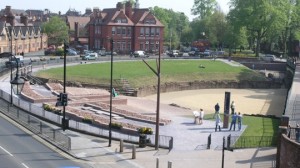Teach your students about Roman civilization with a math connection!

I visited Chester in North England, where my brother lives with his family (he appears briefly in the video with his wife, and my wife and I). Chester is a fascinating town, which stands on top of Roman ruins, many of which no doubt have not yet been found. Basically, whenever a new building project gets underway, archaeologists have to be called in if (or more likely when) ruins are found on the site.
The video includes two on location shoots in Chester, the first at the town’s impressive Roman Amphitheatre, the biggest in Britain; and the second on the City Wall, built by the Romans, which is still largely complete and is a lovely walk around the city.
Math and the Romans
The Roman civilization was incredibly advanced for its time, in just about any field you can name (except perhaps moral behavior): architecture, engineering, military technology and leadership, government, art and fashion, economics, and so on. In many of these fields, mathematics would have been an essential part, just as they are today.
I suggest two straightforward “Roman Math” topics you can use in the primary or middle school classroom:
- Numeration – study Roman numerals, compare and convert with our base ten system
- Geometry – study tessellations and mosaics
With older classes and classes in Europe, other topics will be possible in the curriculum, and so if you are alert to the possibilities, you can link them to mathematics also.
Google Map
The map below shows the locations of the video shoot:
View Chester, England, UK in a larger map
How do you include math in your teaching of history, and ancient civilizations in particular? What other connections do you make with your students with the Romans, Egyptians, Mayans, and so on?
